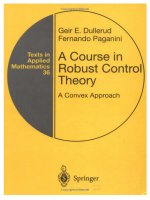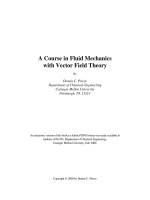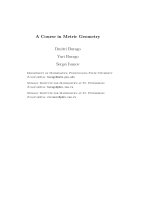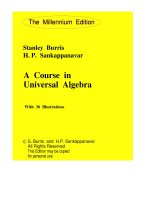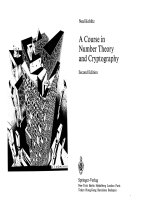A course in simple homotopy theory, marshall m cohen
Bạn đang xem bản rút gọn của tài liệu. Xem và tải ngay bản đầy đủ của tài liệu tại đây (9.72 MB, 124 trang )
Graduate Texts in Mathematics 10
Managing Editor: P. R. Halmos
M. M. Cohen
A Course in SimpleHomotopy Theory
Springer-Verlag New York· Heidelberg· Berlin
Marshall M. Cohen
Associate Professor of Mathematics, Cornell University, Ithaca
AMS Subject Classification (1970)
57 C 10
All rights reserved.
No part of this book may be translated or reproduced in
any form without written permission from Springer-Verlag.
© 1973 by Springer-Verlag New York Inc.
Library of Congress Catalog Card Number 72-93439.
Softcover reprint of the hardcover 1st edition 1973
ISBN 978-0-387-90055-1
ISBN 978-1-4684-9372-6 (eBook)
DOl 10.1007/978-1-4684-9372-6
To
Avis
PREFACE
This book grew out of courses which I taught at Cornell University and
the University of Warwick during 1969 and 1970. I wrote it because of a
strong belief that there should be readily available a semi-historical and geometrically motivated exposition of J. H. C. Whitehead's beautiful theory of
simple-homotopy types; that the best way to understand this theory is to
know how and why it was built. This belief is buttressed by the fact that the
major uses of, and advances in, the theory in recent times-for example, the
s-cobordism theorem (discussed in §25), the use of the theory in surgery, its
extension to non-compact complexes (discussed at the end of §6) and the
proof of topological invariance (given in the Appendix)-have come from
just such an understanding.
A second reason for writing the book is pedagogical. This is an excellent
subject for a topology student to "grow up" on. The interplay between
geometry and algebra in topology, each enriching the other, is beautifully
illustrated in simple-homotopy theory. The subject is accessible (as in the
courses mentioned at the outset) to students who have had a good onesemester course in algebraic topology. I have tried to write proofs which meet
the needs of such students. (When a proof was omitted and left as an exercise,
it was done with the welfare of the student in mind. He should do such
exercises zealously.)
There is some new material here1-for example, the completely geometric
definition of the Whitehead group of a complex in §6, the observations on the
counting of simple-homotopy types in §24, and the direct proof of the
equivalence of Milnor's definition of torsion with the classical definition,
given in §16. But my debt to previous works on the subject is very great.
I refer to [Kervaire-Maumary-deRham], [Milnor 1] and above all [J. H. C.
Whitehead 1,2,3,4]. The reader should turn to these sources for more material,
alternate viewpoints, etc.
I am indebted to Doug Anderson and Paul Olum for many enlightening
discussions, and to Roger Livesay and Stagg Newman for their eagle-eyed
reading of the original manuscript. Also I would like to express my appreciation to Arletta Havlik, Esther Monroe, Catherine Stevens and Dolores
Pendell for their competence and patience in typing the manuscript.
My research in simple-homotopy theory was partly supported by grants
from the National Science Foundation and the Science Research Council of
Great Britain. I and my wife and my children are grateful to them.
Cornell University
Ithaca, New York
February, 1972
Marshall M. Cohen
1 Discovered by me and, in most instances, also by several others. References will be
given in the text.
vii
TABLE OF CONTENTS
Preface .
1.
If.
lIT.
IV.
V.
vii
Introduction
§1. Homotopy equivalence
§2. Whitehead's combinatorial approach to homotopy theory.
§3. CW complexes
2
4
A Geometric Approach to Homotopy Theory
§4. Formal deformations .
§5. Mapping cylinders and deformations
§6. The Whitehead group of a CW complex
§7. Simplifying a homotopically trivial CW pair
§8. Matrices and formal deformations
14
16
20
23
27
Algebra
§9. Algebraic conventions
§1O. The groups KG(R)
§11. Some information about Whitehead groups
§12. Complexes with preferred bases [= (R,G)-complexesj
§13. Acyclic chain complexes
§14. Stable equivalence of acyclic chain complexes.
§15. Definition of the torsion of an acyclic complex
§16. ,Milnor's definition of torsion
§17. Characterization of the torsion of a chain complex
§18. Changing rings
36
37
42
45
47
50
52
54
56
58
Whitehead Torsion in the CW Category
§19. The torsion of a CW pair - definition
§20. Fundamental properties of the torsion of a pair
§21. The natural equivalence of Wh(L) and EB Wh (7r,L j )
§22. The torsion of a homotopy equivalence .
§23. Product and sum theorems .
§24. The relationship between homotopy and simple-homotopy
§25. Invariance of torsion, h-cobordisms and the Hauptvermutung
62
67
70
72
76
79
81
Lens Spaces
§26. Definition of lens spaces
§27. The 3-dimensional spaces Lp. q
§28. Cell structures and homology groups
§29. Homotopy classification
85
87
89
91
ix
Table of Contents
x
§30. Simple-homotopy equivalence of lens spaces
§31. The complete classification .
97
. 100
Appendix: Chapman's proof of the topological invariance of
Whitehead Torsion .
102
Selected Symbols and Abbreviations
107
Bibliography
109
Index
113
A Course in Simple-Homotopy Theory
Chapter I
Introduction
This chapter describes the setting which the book assumes and the goal
which it hopes to achieve.
The setting consists of the basic facts about homotopy equivalence and
CW complexes. In §1 and §3 we shall give definitions and state such facts,
usually without formal proof but with references supplied.
The goal is to understand homotopy theory geometrically. In §2 we
describe how we shall attempt to formulate homotopy theory in a particularly
simple way. In the end (many pages hence) this attempt fails, but the theory
which has been created in the meantime turns out to be rich and powerful in
its own right. It is called simple-homotopy theory.
§1. Homotopy equivalence and deformation retraction
We denote the unit interval [0,1] by 1. If X is a space, I x is the identity
function on X.
If f and g are maps (i.e., continuous functions) from X to Y then f is
homotopic to g, written f ~ g, if there is a map F: X x / -> Y such that
F(x,O) = f(x) and F(x,I) = g(x), for all x EX.
f:X -+ Y is a homotopy equivalence if there exists g: Y -+ X such that
gf ~ Ix andfg ~ I y. We write X ~ Y if X and Yare homotopy equivalent.
A particularly nice sort of homotopy equivalence is a strong deformation
retraction. If X c Y then D: Y -+ X is a strong deformation retraction if there
is a map F: Y x I -+ Y such that
(1) Fo = Iy
(2) Ft(x) = x for all (x,t) E X x /
(3) F 1 (y) = D(y) for all y E Y.
(Here F t : Y -+ Y is defined by FlY) = F(y,t).) One checks easily that D is a
homotopy equivalence, the homotopy inverse of which is the inclusion map
i:X c Y. We write Y'-... X if there is a strong deformation retraction from
Yto x.
Iff: X -+ Y is a map then the mapping cylinder M f is gotten by taking the
disjoint union of X x / and Y (denoted (X x /) EB Y) and identifying (x,I)
withf(x). Thus
M = (X x /) EB Y
f
(x,I) = f(x) .
The identification map (X x /) EB Y
-+
1
M f is always denoted by q. Since
2
Introduction
q!X x [0,1) and q! Yare embeddings, we usually write q(X x 0) = X and
q( Y) = Y when no confusion can occur. We also write q(z) = [z] if
ZE(X x I) EEl Y.
(1.1) Iff: X
->-
Y then the map p:Mf
p[x,t]
=
[x,I]
->-
=
Y, given by
[f(x)] ,
pry] = [y]
t
<
yE Y
is a strong deformation retraction.
The proof consists of "sliding along the rays of M f
details.) 0
(1.2) Suppose that f:X
Then
->-
."
(See [Hu, p. 18] for
Y is a map. Let i:X ->- M f be the inclusion map.
(a) The following is a commutative diagram
(b) i is a homotopy equivalence
iff f
is a homotopy equivalence.
Part (a) is clear and (b) follows from this and (1.1). 0
§2. Whitehead's combinatorial approach to homotopy theory
Unfortunately, when given two spaces it is very hard to decide whether
they are homotopy equivalent. For example, consider the 2-dimensional
complex H-"the house with two rooms"-pictured at the top of page 3.
H is built by starting with the wall Sl x I, adding the roof and ground floor
(each a 2-disk with the interior of a tangent 2-disk removed), adding a middle
floor (a 2-disk with the interiors of two 2-disks removed) and finally sewing in
the cylindrical walls A and B. As indicated by the arrows, one enters the lower
room from above and the upper room from below. Although there seems to
be no way to start contracting it, this space is actually contractible (homotopy
equivalent to a point). It would be nice if homotopy theory could tell us why
in very simple terms.
In the 1930's one view of how topology ought to develop was as combinatorial topology. The homeomorphism classification of finite simplicial complexes had been attacked (most significantly in [ALEXANDER]) by introducing
elementary changes or "moves", two complexes K and L being "combinatorially equivalent" if one could get from K to L in a finite sequence of such
moves. It is not surprising that, in trying to understand homotopy equivalence,
J. H. C. WHITEHEAD-in his epic paper, "Simplicial spaces, nucleii and
Whitehead's combinatorial approach to homotopy theory
3
H
m-groups"-proceeded in the same spirit. We now describe the notions which
he introduced.
If K and L are finite simplicial complexes we say that there is an elementary
simplicial collapse from K to L if L is a subcomplex of K and K = L u aA
where a is a vertex of K, A and aA are simplexes of K, and aA n L = aA.
Schematically,
We say that K collapses simplicially to L--written K 'l L-if there is a finite
sequence of elementary simplicial collapses K = Ko -+ Kl -+ ... -+ Kq = L.
For example, any simplicial cone collapses simplicially to a point.
b
a~c
d
"Z
a------
b
• a
If K 'l L we also write L yt K and say that L expands simplicially to K.
We say that K and L have the same simple-homotopy type 2 if there is a finite
2
This is modern language. Whitehead originally said "they have the same nucleus."
Introduction
4
sequence K = Ko -+ Kl -+ ... -+ Kq = L where each arrow represents a
simplicial expansion or a simplicial collapse.
Since an elementary simplicial collapse easily determines a strong deformation retraction (unique up to homotopy) it follows that, if K and L have the
same simple-homotopy type, they must have the same homotopy type.
WHITEHEAD asked
If two finite simplicial complexes have the same homotopy type, do they
necessarily have the same simple-homotopy type?
Despite the apparent restrictiveness of expanding and collapsing, it is quite
conceivable that the answer to this question might be yes. To illustrate this
and to show that simple-homotopy type is a useful notion, let us return to the
house with two rooms.
Think of H as being triangulated as a subcomplex of the solid cylinder
D2 x I where D2 x I is triangulated so that D2 x I '!. D2 X 0 '!. *
(= point). Now, if the solid cylinder were made of ideally soft clay, it is clear
that the reader could take his finger, push down through cylinder A, enter
the solid lower half of D2 x I and, pushing the clay up against the walls,
ceiling and floor, clear out the lower room in H. Symmetrically he could then
push up the solid cylinder B, enter the solid upper half and clear it out.
Having done this, only the shell H would remain. Thus we can see (although
writing a rigorous proof would be unpleasant) that
Hence H has the same simple-homotopy type as a point and, a fortiori, His
contractible.
So we shall study the concept of simple-homotopy type, because it looks
like a rich tool in its own right and because, lurking in the background, there
is the thought that it may be identical with homotopy type.
In setting out it is useful to make one technical change. Simplicial complexes are much too hard to deal with in this context. WHITEHEAD'S early
papers [J. H. C. WHITEHEAD 1, 2] are a marvel in that, besides the central
concepts introduced, he overcame an enormous number of difficult technical
problems related to the simplicial category. These technical difficulties later
led him to create CW complexes [J. H. C. WHITEHEAD 3] and it is in terms of
these that he brought his theory to fruition in [J. H. C. WHITEHEAD 4]. In the
next section we summarize the basic facts about CW complexes. In Chapter II
the expanding and collapsing operations are defined in the CW category and
it is in this category that we set to work.
§3. CW complexes
In this section we set the terminology and develop the theorems which will
be used in the sequel. Because of the excellent treatments of CW complexes
CW complexes
5
which exist (especially [SCHUBERT] and [G. W. WHITEHEAD]) proofs of standard
facts which will be used in a standard fashion are sometimes omitted. The
reader is advised to read this section through (3.6) now and to use the rest of
the section for reference purposes as the need arises.
A CW complex K is a Hausdorff space along with a family, {e a}, of open
topological cells of various dimensions such that-letting Kj = U {ealdim ea
::s; J}-the following conditions are satisfied:
CW 1: K =
U ea, and earl ep
= 0 whenever
ex
# (3.
CW 2: For each cell ea there is a map CPa: Qn -»- K, where Qn is a topological ball (homeomorph of r = [O,ln of dimension n = dim ea , such that
(a) CPa I Qn is a homeomorphism onto ea.
(b) cpaCoQn) c K n- '
CW 3: Each i?ao is contained in the union of finitely many ea.
CW 4: A set A c K is closed in K iff A rl i?a is closed in i?a for all ea.
Notice that, when K has only finitely many cells, CW 3 and CW 4 are automatically satisfied.
A map cP: Qn -»- K, as in CW 2, is called a characteristic map. Clearly such
a map cP gives rise to a characteristic map cp':r -»- K, simply by setting cp' = cph
for some homeomorphism h:r -»- Qn. Thus we usually restrict our attention
to characteristic maps with domain r, although it would be inconvenient to
do so exclusively. Another popular choice of domain is the n-ball
r = Closure (or+l-r).
If cp: Qn -»- K is a characteristic map for the cell e then cploQn is called
an attaching map for e.
A subcomplex of a CW complex K is a subset L along with a subfamily
{e p } of the cells of K such that L = U ep and each i?{J is contained in L. It
turns out then that L is a closed subset of K and that (with the relative topology) L and the family {ep} constitute a CW complex. If L is a subcomplex
of K we write L < K and call (K,L) a CW pair. If e is a cell of K which does
not lie in (and hence does not meet) L we write e EO K - L.
Two CW complexes K and L are isomorphic (denoted K ~ L) if there
exists a homeomorphism h of K onto L such that the image of every cell of
K is a cell of L. In these circumstances h is called a CW isomorphism. Clearly
h - 1 is also a CW isomorphism.
An important proRerty of CW pairs is the homotopy extension property:
(3.1) Suppose that L < K. Given a map I: K -»- X (X any space) and a
homotopy I,:L -»- X such that 10 = IlL then there exists a homotopy
F,:K -»- X such that Fo = I and F,IL = I,lL, O::s; t ::s; I. (Reference:
[SCHUBERT, p. 197]).
D
As an application of (3.1) we get
Introduction
6
(3.2) If L < K then the following assertions are equivalent:
(1) K L;. L
(2) The inclusion map i:L c K is a homotopy equivalence.
(3) 7Tn (K, L) = 0 for all n :::; dim (K - L).
COMMENT ON PROOF: The implications (1) => (2) and (2) => (3) are
elementary. The implication (3) => (1) is proved inductively, using (3) and
the homotopy extension property to construct first a homotopy (reI L) of lK
to a map fo: K -+ K which takes K O into L, then to construct a homotopy
(reI L) of fo to fl : K -+ K such thatfl (KI) c L, and so on. 0
If Ko and KI are CW complexes, a map f: Ko -+ KI is cellular if
f(K'O) c K7 for all n. More generally, if (Ko,Lo) and (KI,L I ) are CW pairs,
a map f:(Ko,Lo) -+ (KI,L I) is cellular if f(K'O U Lo) c (K7 U L I) for all n.
Notice that this does not imply that flLo :Lo -+ LI is cellular. As a typical
example, suppose that /" is given a cell structure with exactly one n-ceIl and
suppose thatf:/" -+ K is a characteristic map for some cell e. Thenf:(/", oJ")
-+ (K, K n -I) is cellular while flo/" need not be cellular.
If f ~ g and g is cellular then g is called a cellular approximation to f
(3.3) (The cellular approximation theorem) Any map between CW pairs,
f:(Ko,Lo) -+ (KI,L I ) is homotopic (reI. Lo) to a cellular map. (Reference:
[SCHUBERT, p. 198]). 0
If A is a closed subset of X and f: A -+ Y is a map then Xu Y is the identification space [X EB Y / x = f(x) if x E A].
f
(3.4) Suppose that Ko < K and f: Ko -+ L is a map such that, given any cell
e of K-Ko, fee n Ko) c L n - I where dim e = n. Then K U L is a CW
f
complex whose cells are those of K-Ko and those of L. (More precisely the
cells of K U L are of the form q(e) where e is an arbitrary cell of K - Ko or
f
of Land q: K EB L -+ K
possible). 0
U
L is the identification map. We suppress q whenever
Using (3.4) and the natural cell structure on K x I we get
(3.5) Iff: K -+ L is a cellular map then the mapping cylinder M f is a CW
complex with cells which are either cells of L or which are of the form e x 0 or
e x (0,1), where e is an arbitrary cell of K. 0
Combining (1.2), (3.2) and (3.5) we have
(3.6) A cellular map f: K
M f L;. K. 0
-0-
L is a homotopy equivalence if and only if
CW complexes
7
Cellular homology theory
If (K, L) is a CW pair, the cellular chain complex C(K, L) is defined by
lettingCn(K, L) = Hn(Kn U L, K n- 1 U L) and letting d n:Cn(K, L) -+ C n- 1(K, L)
be the boundary operator in the exact sequence for singular homology of the
triple (Kn U L, K n- 1 U L, K n- 2 U L).
Cn(K, L) is usually thought of as "the free module generated by the
n-cells of K - L". To make this precise, let us adopt, now and forever,
standard orientations Wn of 1"(n = 0,1,2, ... ) by choosing a generator Wo of
Ho(J°) and stipulating that the sequence of isomorphisms
H n (1"-1
1"-1)
-l, 0
excisiofi)H
(o1"Jn-l)~Hn-l (oIn)~H(1"o1")
n-l,
n
,
takes Wn-l onto -Wn" (Here 1"-1 =1"-1 X 0). If ({JCJ.:1"-+K is a
characteristic map for eaEK-L we denote <({Ja> = «({Ja) * (w n) where «((Ja)*:
Hn(Jn, 01") -+ Hn(Kn U L, K n- 1 U L) is the induced map. Then the situation
is described by the following two lemmas.
(3.7) Suppose that a characteristic map % is chosen for each n-cell ea of K-L.
Denote K j = Kj U L. Then
(a) HiKn, K n- 1 ) = 0 if j #- n
(b) Hn(Kn, K n- 1) isfree with basis {<({Ja>le~ E K-L}
(c) If c is a singular n-cycle of K mod L representing y E Hn(Kn, K n- 1 )
and if Ie I does not include the n-cell eao then nao = 0 in the expression
y =
na <%.>· (Reference: [G. W. WHITEHEAD, p. 58] and [SCHUBERT,
L
t1.
p.300]).
D
A cellular map f: (K,L) -+ (K',L') clearly induces a chain map
f*: C(K,L) -+ C(K',L') and thus a homomorphism, also called f*, from
H(C(K,L)) to H(C(K',L')). Noting this, the cellular chain complex plays a
role in the category of CW complexes analogous to that played by the
simplicial chain complex in the simplicial category because of
(3.8) There is a natural equivalence T between the "cellular homology"
functor and the "singular homology" functor. In other words, for every CW
pair (K,L) there is an isomorphism TK,L:H(C(K,L)) -+ H(IKI, ILl), and for
every cellular map f: (K,L) -+ (K',L') the following diagram commutes
H(C(K,L))
TK,L)
f·1
H(C(K',L')) - - '
TK'L'
---:>-)
H(IKI,
ILl)
f.
1
H(IK'I, IL'!)
The isomorphism TK,L takes the homology class of a cycle
onto the homology class of the cycle
I
I
ni<({Ja) E CnCK, L)
i
n/Pa,
i
E
Sn(K, L), where
chain representing <({Ja)' (Reference: [G. W. WHITEHEAD, p. 65] and [SCHUBERT,
p.305]).
D
8
Introduction
(3.9) Suppose that f: K --+ L is a cellular map with mapping cylinder M J'
Then C(MJ,K) is naturally isomorphic to the chain complex (qj',o)-"the
mapping cone" ofj~: C(K) --+ C(L)-which is given by
qj'n
0n(x+y)
=
=
Cn-I(K) EEl Cn(L)
-dn-I(X)+[f*(x)+d~(y)],
XECn_I(K),
YECn(L)
where d and d' are the boundary operators in C(K) and C(L) respectively.
By "naturally isomorphic" we mean that, for each n, the isomorphism
constructed algebraically realizes the correspondence between n-cells of
MJ-Kand cells of Kn-luL n given by en- l x(O,I) +4 en- l and un +4 un
(e n - l a cell of K, un a cell of L).
PROOF OF (3.9): Let {e a } be the cells of K and suppose that characteristic
maps CPa have been chosen. Then (Kx I, Kx 0) is a CW pair with relative
cells of the form ea x 1 and ea x (0,1) possessing the obvious characteristic
maps CPa. I and CPa X II' If dim ea = n-I, let (CPa) = fPa,I*(W n- l ) and
(CPa) X I = (CPa X II)*(w n) be the corresponding basis elements of
C(Kx I, Kx 0). In general, if c = I ni(cpa) is an arbitrary element of
Cn - I (K), set c x I
=
I
i
i
n;( (CPa)
X
I). In the product cell structure for I" we
have Wn E CnCI") and (exercise-induction on n suggested) dW n
n
=
I
(-1)"- j
j~l
(ij,I*Wn-l-ij,o*Wn-l) E Cn_l(In) where ij,,:I"-1 --+I" is the characteristic
map ij,it l , ... ,tn- I ) = (tl'" .,tj_l,e,tj, ... ,tn- I ), e = 0,1. This gives dW n =
in,I*Wn-I-in,o*Wn-I-(dwn_lxI). Interpreted in C(I",I"-lxO) this becomes dW n = in,1*Wn-1-(dwn-1 xI), and applying the chain map (fPax II)*
we get
de< CPa) X I) = (CPa) - (d)CPa) X I) E Cn - 1(K X I, K X 0).
Let {up} be the cells of L, with characteristic maps tPp. Then
q*: C(Kx I, Kx 0) EEl C(L) --+ C(MJ,K), and C(MJ,K) has as basis-from
the natural cell structure of M J-the set
.
{q*( (CPa)
X
I) lea
E
K} u {q*(tPp) /up E L},
Define a degree-zero homomorphism T: C(MJ,K) --+ qj' by stipulating that
T(q*«CPa) xl») = (CPa) and T(q*(tPp» = (tPp). Notice that (with the
obvious identifications) Tq* /C(Kx 1) = f*: C(K) --+ C(L) and Tq*(c X I) = c
for all c E C(K). Thus
Td[q*( (CPa)
X
I)] = Tq*d[ (CPa)
X
1]
=
Tq*[(CPa)-(d(fPa) xI)]
=
Tq*«CPa»-Tq*(d(CPa) X I)
f*(CPa) -d(CPa)
o(CPa) = oT[q*«CPa) xI)]
=
=
It follows trivially that T is a chain isomorphism.
0
CW complexes
9
Covering spaces
We turn now to covering spaces. Connectivity of the base space will be
assumed throughout this discussion
(3.10) If K is a CW complex then K is locally contractible. Thus for any
subgroup G c 7Tj(K) there is a covering spacep: E ~>- K such that p#(7T jE) = G.
In particular K has a universal covering space. (Reference: [SCHUBERT,
p.204]).
0
We define p: E --+ K to be a covering in the CW category provided that p
is a covering map and that E and K are CW complexes such that the image of
every cell of E is a cell of K. By a covering we shall always mean a covering
in the CW category if the domain is a CW complex. Nothing is lost in
doing this because of
(3.11) Suppose that K is a CW complex and p: E --+ K is a covering of K. Then
{e"le" E K, e" is a lift of e" to E}
is a cell structure on E with respect to which E becomes a CW complex. If
rp,,: r --+ K is a characteristic map for the cell e", if e" is a I(ft of e" and if
(3.12) If p: E
]: K'
--+
--+ K is a covering andf: K' --+ K is a cellular map which lifts to
E then J is cellular. Iff is a covering (in the CW category), so is]. 0
Since a covering which is also a homeomorphism is a cellular isomorphism,
(3.12) implies that the universal covering space of K is unique up to cellular
isomorphism.
(3.13) Suppose that (K, L) is a pair of connected CW complexes and that
p:K --+ K is the universal covering. Let L = p-jL. If i# :7T jL ~ 7T j K is an
isomorphism then pi L: L --+ L is the universal covering of L. If; further,
K '" L then K '" L.
PROOF: Lis a closed set which is the union of cells of K (namely, the lifts of
the cells of L). Thus L is a sUbcomplex of K. Clearly pi L is a covering of L.
We shall show that, if i# is an isomorphism, L is connected and simply
connected. Notice that, by the covering homotopy property,
P# :7Ti(K,L) ~ 7T i(K, L) for all i :?: 1. To see that Lis connected, notice that
7Tl(K, L) = 0 since we have exactness in the sequence
7T 1 (L)
Thus 7TICK, L)
sequence
=
-
-
--=-,.. 7T 1 (K) --+ 7T 1 CK, L) --+ 7ToCL) --=-,.. 7To(K).
O. Hence by the connectedness of K and the exactness of the
it follows that L is connected.
Introduction
10
Lis I-connected because of the commutativity of the diagram
Hence p: L -7 L is the universal covering.
Finally, K '"" L implies 7Ti(K, L) = 0 and hence 7Ti(K, L) =
i ;::: 1. Thus K '"" Lby (3.2). 0
°for all
(3.14) Suppose that f: K -7 L is a cellular map between connected complexes
such that f# :7TIK -7 7TIL is an isomorphism. If K, L are universal covering
spaces of K, Land l: K -7 L is a lift ofj, then M j is a universal covering space
ofMf ·
Exercise: Give a counter-example whenf# is not an isomorphism.
PROOF OF (3.14): J is cellular and M j '4 L, so M j is a simply connected
CW complex. Let p: K -7 K and p': L -7 L be the covering maps. Define
IX:Mj -7 M f by
O([w, t] = [pew), t],
O:::;t:::;l,wEK
O([z]
= [p'(z)] ,
ZE
L
If [w, I] = [z] then Jew) = z, so O([w, 1] = [pew), 1] = [fp(w)] = [p:t(w)]
= [p'(z)]. Hence 0( is weIl-defined. It is clearly continuous. Notice that
O(I(Mj-L) = O(IKx[O, I) =PXI[O,I) and O(IL=p'. Thus O(IMj-L) and
0( L are covering maps, and 0( takes cells homeomorphically onto cells.
Let (3:M f -7 M f be the universal cover of M f , with K = (3-1(K),
L = (3-1(L). By (3.13), (3IL: L -7L is a universal covering. Since
f# :7T 1K -7 7TIL is an isomorphism, so, by (1.2), is i# :7TIK -7 7T J M f . Hence K
is simply connected, using (3.13) again. But clearly (31(Mf -L):Mf -L
-7 Mf-L is a covering and 7Ti(Mf-L, K) = 7Ti(Mf-L, K) = 0 for all i.
So Mf-L is simply connected and (31(Mf -L) is a universal covering also.
Now let &: M j -7 Mf be a lift of 0(. By uniqueness of the universal covering
spaces of Mf-L and L, & must take M j - Lhomeomorphically onto Mf-L
and L homeomorphically onto L. Thus & is a continuous bijection. But it is
clear that & takes each cell e homeomorphically onto a cell aCe). Then & takes
e bijectively, hence homeomorphically, onto aCe). The latter is just aCe)
because if cp is a characteristic map for e, &cp is a characteristic map for aCe),
so that aCe) = &cp(r) = aCe). Since M j and M f have the weak topology with
respect to closed cells it follows that & is a homeomorphism. Since (3& = IX
it follows that IX is a covering map. 0
Consider now the cellular chain complex CCK, L), where K is the universal
covering space of K and L < K. Besides being a "I-module with the properties
given by (3.7) and (3.8), C(K,L) is actually a £'(G)-module where G is the
1
CW complexes
II
group of covering homeomorphisms of R or, equivalently, the fundamental
group of K. We wish to explain how this richer structure comes about.
Recall the definition: If G is a group and Z is the ring of integers then
Z(G)-the integral group ring of G~-is the set of all finite formal sums
L nig i , ni E Z, gi E G, with addition and multiplication given by
i
L nig i
+
L mig i
=
L (ni+m;)gi
i i i
(L nigi)'(L mjgJ = L (nim) (gig)
i
i,)
j
One can similarly define !R(G) for any ring IR.
Let p: R -+ K be the universal covering and let G = Cov (R) = [the set of
all homeomorphisms h: R -+ R such that ph = pl. Suppose that L < K and
L = p -1 L. Each g EGis (3.12) a cellular isomorphism of R inducing, for
each 11, the homomorphism g*: c.(R, L) -+ c.(R, L) and satisfying
dg* = g*d (where d is the boundary operator in C(R, L». Let us define an
action of G on qR,L) by g'C = g*(c), (g E G, c E qR,L». Clearly
d(g·c) = g·(dc). Thus qR,L) becomes a Z(G)-complex if we define
(L nig i)' c
=
L ni(g;" c)
=
L ni(g;)*(c)
i i i
The following proposition shows that C(R, L) is a free l(G)-complex with a
natural class of bases.
(3.15) Suppose that p: R -;> K is the universal covering and that G is the group
of covering homeomorphisms of R. Assume that L < K and L = p- 1L. For
each cell e, of K-L let a specific characteristic map cP,:/" -+ K (n = n(a»
and a specific lift CPa: /" -+ R of cP, be chosen. Then {(CPa) Ie, E K - L} is a basis
for c(R,L) as a l(G)-complex.
* = *n be a fixed point of 1n for each 11. For eachy Ep-lcpa(*),
let
basis
PROOF: Let
0
where g varies over G and cP, varies over the given characteristic maps for
K - L. Thus each c E C(K, L) is uniquely representable as a finite sum
c
=
L ni,a(g;, (CPa»
f,CI.
= L (L l1i,agi)' (CPa)
a
i
= L ra(cpa), ra E leG)
a
Therefore {(CPa) lea is a cell of K-L} is a basis of qR,L) as a l(G)-module. 0
Introduction
12
The fundamental group and the group of covering transformations
If we choose base points x E K and x E p -lex) then there is a standard
identification of the group of covering transformations G with 7TI K = 7TI (K,x).
Because of its importance in the sequel, we review this in some detail.
For each a :(1) ---J> (K,x), let fi be the lift of a with fiCO) = x. Let g[a):K ->- K
be the unique covering homeomorphism such that g[aP') = fi(l). We claim
that, if y E K and if w :(1,0, I) ---J> (K,x,y) is any path, then
where pw is the composition of wand p, and "*" represents concatenation of
loops. To see this, note that ~(l) =
where P
lift. Hence p1v = g[a)
and
Pw(l)
0
0
Pw
The function 8 = 8(X,X):7TIK ---J> G, given by [a]---J> g[a), is an isomorphism.
For example, it is a homomorphism because, for arbitrary [a], [,B] E 7T I K, we
have (by the preceding paragraph)
g[aig[Pi x » = g[a)(~(1»
=
...--:-
Mp,B(1)
,--'.
= a*,B(l)
= g[a)[P)(x)
Hence g[a) 0 g[P) = g[a)[p), since they agree at a point.
Suppose that p:K ---J> K and p': l---J> L are universal coverings with
p(x) = x and p'(y) = y, and that GK and GL are the groups of covering
transformations. Then any map 1:(K,x) ---J> (L,y) induces a unique map
1# :G K ->- G L such that the diagram
commutes. (We believe that it aids the understanding to call both maps/#.)
This map satisfies
(3.16) II g
E
GK and .f:(K,x)
---J>
(l,y)
covers I, then 1# (g) 01 = log.
PROOF: Since these maps both cover I, it suffices to show that they agree at
CW complexes
13
a single point-say x. So we must show that (j~(g»(ji) = hex). Letting ex be a
loop such that [ex] corresponds to g under 8(x,x), we have
19(x) = la(!)
~
=
(fa ex)(1),
=
(8(y,ji)(f#[cx]))(ji),
=
((8(y,ji)f#8(x,x)-I)(g»(ji)
=
(f#(g»(ji).
since N(O)
D
= ji =
,...,
fex(O)
where f# :1T J(K,x)
-c>-
1TJ(L,y)
Chapter II
A Geometric Approach to Homotopy Theory
From here on all CW complexes mentioned will be assumed finite unless
they occur as the covering spaces of given finite complexes.
§4. Formal deformations
Suppose that (K, L) is a finite CW pair. Then K 'f. L-i.e., K collapses to
L by an elementary collapse-iff
(1) K = L U e"-l U e" where e" and e"-l are not in L,
(2) there exists a ball pair (Q", Q"-l) ;;:::
such that
cr, 1"-1) and a map cp: Q" -+ K
(a) cp is a characteristic map for e"
(b) cplQn-,l is a characteristic map for en- 1
(c) cp(pn-l) c L"-l, where pn-l == Cl(8Q"- Q"-l).
In these circumstances we also write L ;;r K and say that L expands to K by an
elementary expansion. It will be useful to notice that, if (2) is satisfied for one
ball pair (Q", Qn-l), it is satisfied for any other such ball pair, since we need
only compose cp with an appropriate homeomorphism.
Geometrically, the elementary expansions of L correspond precisely to
the attachings of a ball to L along a face of the ball by a map which is almost,
but not quite, totally unrestricted. For, if we set CPo = cplpn-l in the above
definition, then CPo:(P"-I, 8P"-1) -+ (L"-I, L"-2) and
(K, L) ~ (L u Q", L).
'1'0
Conversely, given L, any map CPo: (pn-l, oP"-l) -+ (L"-l, L"- 2) determines
an elementary expansion. To see this, set K = L u Qn. Let cp:L EB Q" -+ K
'po
be the quotient map and define cp( Qn - 1) = en - 1, cp( Q") = en. Then K
L U e"-l U e" is a CW complex and L;;r K.
14
=
Formal deformations
15
(4.1) If K ~ L then (a) there is a cellular strong deformation retraction
D: K -J> Land (b) any two strong deformation retractions of K to L are homotopic reI L.
PROOF. Let K = L U en- 1 U en. By hypothesis there is a map
<Po:I"-1-J>Ln - 1 such that (K,L) ~ (LUI",L). But LuI" is just the
~o
~o
mapping cylinder of <Po. Hence, by (1.1) and its proof there is a strong deformation retraction D: K -J> L such that D(e") =
If D 1 and D 2 : K -J> L are two strong deformation retractions and
i:L c K then iDl ~ lK ~ iD2 rei L. So Dl = DliDl ~ DliD2 = D 2. 0
We write K~ L (K collapses to L) and L)1 K (L expands to K) iff there
is a finite sequence (possibly empty) of elementary collapses
K
= Ko
~
KJ ~
•••
~
Kq
= L.
A finite sequence of operations, each of which is either an elementary expansion or an elementary collapse is called a formal deformation. If there is a
formal deformation from K to L we write K A L. Clearly then, L A K.
K and L are then said to have the same simple-homotopy type. If K and L have
a common subcomplex K o, no cell of which is ever removed during the
formal deformation, we write K A L rei Ko.
Suppose that K = Ko -J> Kl -J> ••• -J> Kq = L is a formal deformation.
Define fi: Ki -J> K i+ 1 by letting fi be the inclusion map if Ki ;71 K i+ 1 and,
(4.1), lettingfi be any cellular strong deformation retraction of Ki onto K i + 1
if Ki ~ K i + l' Then f = fq-l' . .flj~ is called a deformation. It is a cellular
homotopy equivalence which is uniquely determined, up to homotopy, by
the given formal deformation. If K' < K and f = fq-l ... fo: K ->- L is a
deformation with eachfilK' = I (so K A L rei K'), then we say that f is a
deformation reI K'.
Finally, we define a simple-homotopy equivalence f: K ->- L to be a map
which is homotopic to a deformation.jis a simple-homotopy equivalence reI K'
if it is homotopic, rei K', to a deformation rei K'.
Some natural conjectures are
(I) If f:K --+ L is a homotopy equivalence then f is a simple-homotopy
equivalence.
(II) If there exists a homotopy equivalence from K to L then there exists
a simple-homotopy equivalence.
In general, both conjectures are false. 3 But in many special cases (e.g., if
7T1L = 0 or 7L (integers» both conjectures are true. And for some complexes
L, (I) is false while (II) is true.
In the pages ahead, we shall concentrate on (I)-or, rather, on the
equivalent conjecture (I') which is introduced in §S. Roughly, we will follow
WHITEHEAD'S path. We try to prove that (I) is true, run into an obstruction,
3
See (24.1) and (24.4).
16
A geometric approach to homotopy theory
get some partial results, start all over and algebraicize the theory, and finally
end up with a highly sophisticated theory which is, in the light of its evolution,
totally natural.
Exercises:
4.A. If K \,;. L then any given sequence of elementary collapses can be
reordered to yield a sequence K = Ko's. KI 's. ... 's. Kq = L with
n. U
n·-I
h
K i = K i+1 U e'
e'
wereno:2:nl:2:···:2:nq_l·
4.B. If K is a contractible I-dimensional finite CW-complex and x is any
O-cell then K \,;. x.
4.C. If K \,;. x for some x E K O then K \,;. y for all y E KO.
4.D. If K AI L then there are CW complexes P and L' such that
K / P \,;. L' ~ L. (In essence: all the expansions can be done first.)
§5. Mapping cylinders and deformations
In this section we introduce some of the important facts relating mapping
cylinders and formal deformations. The section ends by applying these facts
to get a reformulation of conjecture I of §4.
(5.1) Iff: K ---+ L is a cellular map and if Ko < K then M J \,;. M JIKo .
PROOF: Let K = Ko U e 1 U ... U er where the ei are the cells of K-Ko
arranged in order of increasing dimension. Then Ki = K o U e 1 U ... U ei
is a subcomplex of K. We set Mi = M JIK , and claim that Mi's. M i - 1 for
all i. For let fIJi be a characteristic map for e i and let q:(Ki x I) EB L ---+ Mi
be the quotient map. Then Mi = M i - 1 U e i U (e i x (0, 1»
and
q (CPi xl): /"' x I ---+ M; is a characteristic map for (e i x (0, 1» which restricts
on /"' x to a characteristic map for e i . Clearly the complement of /"' x in
8(/"'xI) gets mapped into M7'--1. Hence Mi's. M i - 1. Therefore
0
°
M J \,;. M JIKo •
°
0
Corollary (5.lA): Iff:K ---+L is cellular then M J
\,;.
L.
Corollary (5.1B): If K o < K then (Kx I) \,;. (Ko x I)
or 1. 0
0
U
(Kx i), i =
Corollary (5.lC): If Ko < vK and K is the cone on K then vK \,;. vKo·
°
0
Since we shall often pass from given CW complexes to isomorphic complexes without comment, we give the following lemma at the very outset.
(5.2): (a) If(K, K 1, K 2) is a triple which is CW isomorphic to (J, J 1 , J2) and if
K AI Kl reI K2 then J AI J 1 ref J2.
(b) If K 1, K2 and L are CW complexes with L < Kl and L < K2 and if
h: Kl ---+ K2 is a CW isomorphism such that h IL = 1 then Kl AI K2 rei L.

